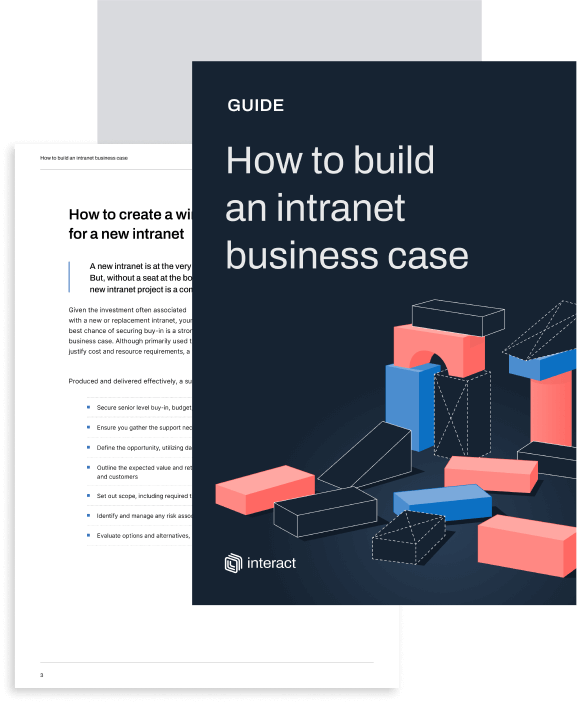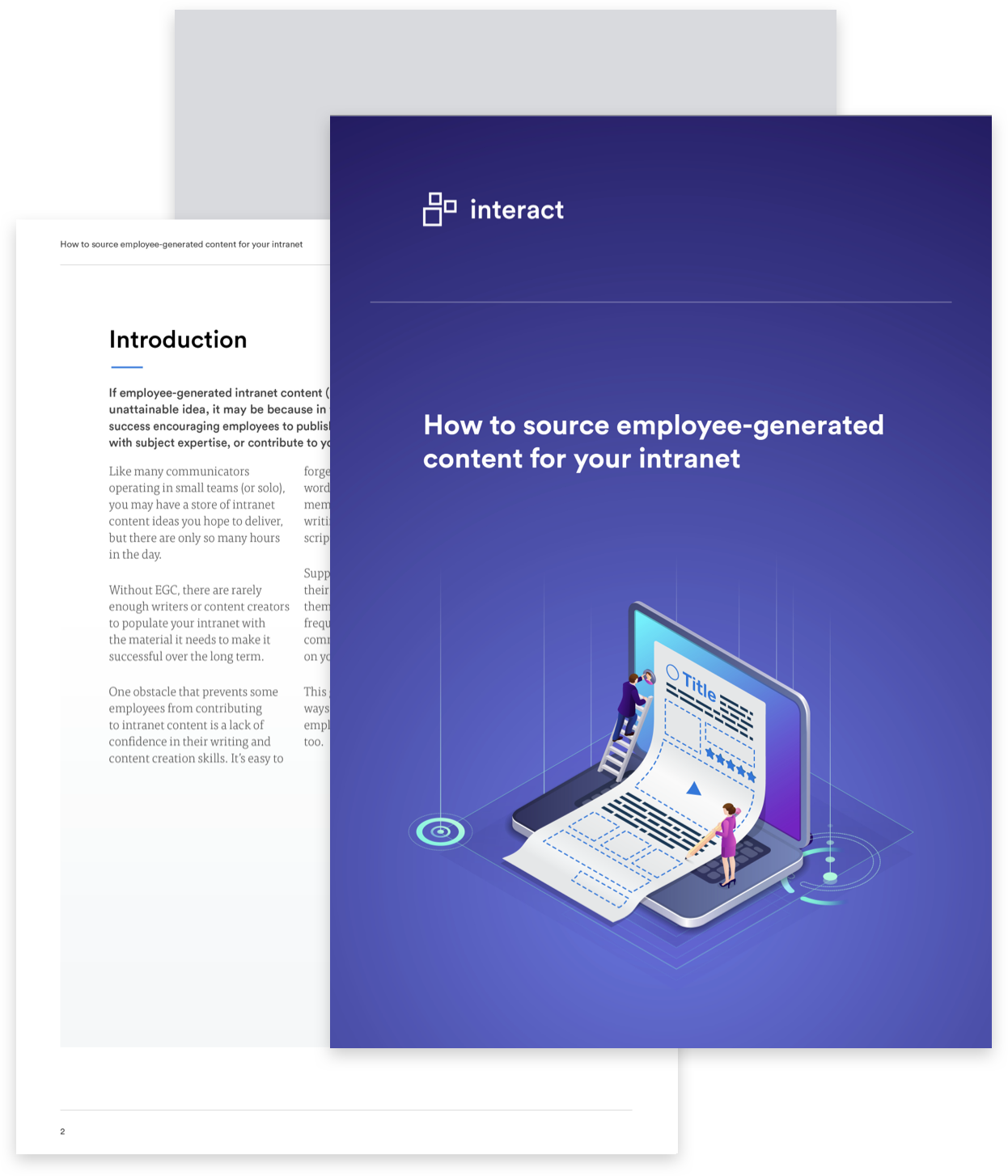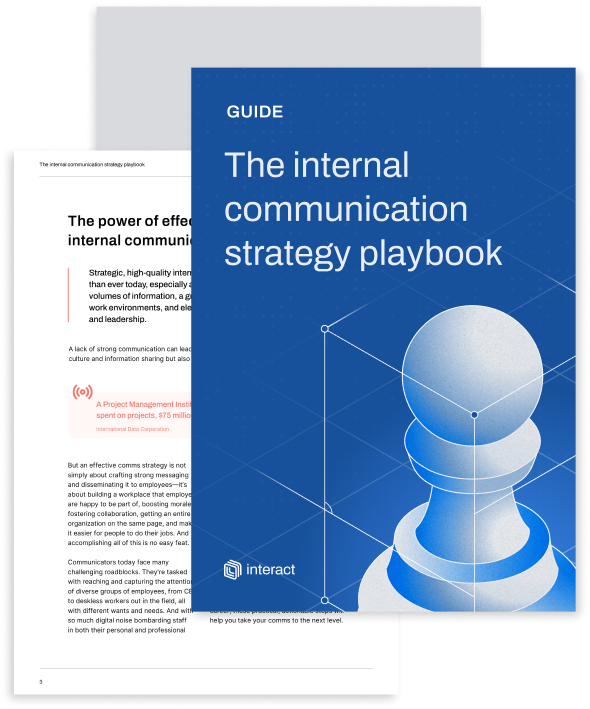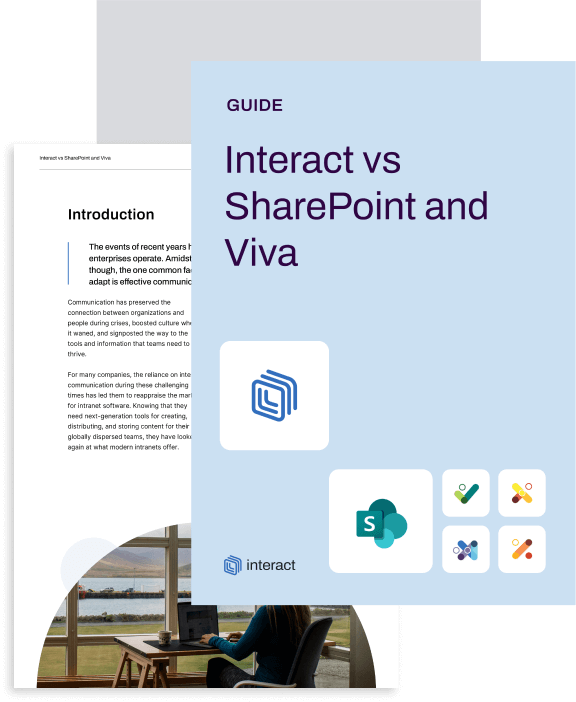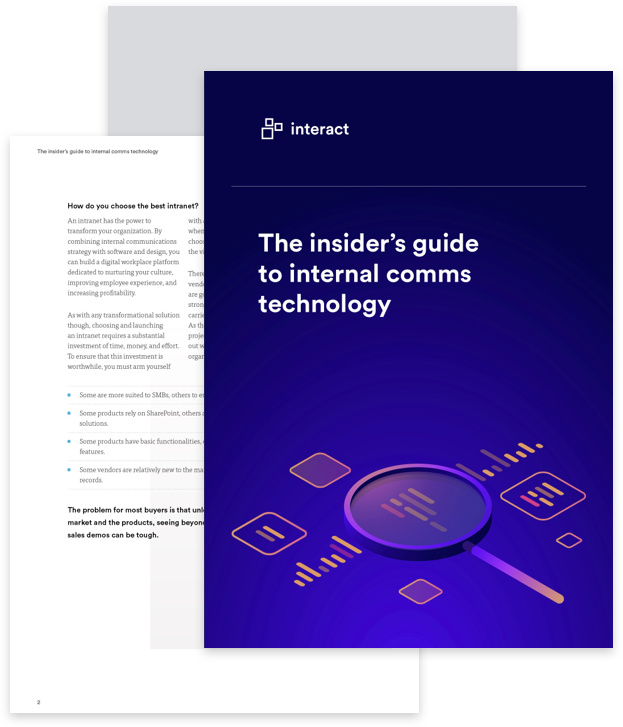Every organization has subject-matter experts. They are the indispensable individuals who know your product, service, processes, or customers inside out. It’s critical to identify and work with subject-matter experts if you want to minimize knowledge hoarding, create silo-free collaboration, and improve intranet content.
From the person who understands SharePoint to the one with knows how you stack up against competitors, subject-matter experts (SMEs) are the workplace authorities everyone turns to for advice.
Indeed defines subject-matter experts as:
Professionals who have advanced knowledge in a specific field. As an authority in a particular area or topic, they are uniquely qualified to provide guidance and strategy. SMEs are especially in high demand in workplaces requiring a technical approach to operations and culture.
Organizations utilize these experts in a variety of ways, ranging from recording what they know in an organized manner to relying solely on informal relationships.
What those enterprises with more established SME-related structures have realized, however, is how important it is to capture and share the knowledge possessed by informed individuals. For those lacking formal connections between SMEs and the business though, there is further to go.
Without recording and teaching others what your SMEs know, there is always the chance they will leave and take their highly developed understanding with them. At that point, the knowledge drain can become costly to the organization and its bottom line.
This article sets out how intranet managers and internal communications professionals can improve knowledge management by working with subject-matter experts on company intranet content.
Building an intranet business case
Who are your subject-matter experts?
Before planning how to help SMEs contribute to your intranet and its knowledge base, you need to know who they are.
Subject-matter experts can be identified by several common traits.
- They are knowledgeable – SMEs are deeply versed in at least one subject. They are likely to have gained this through a mixture of on-the-job experience and education. The thing that marks out serious experts is that they often undertake independent study purely because they are interested in a topic.
- They are experienced – Typically, SMEs will have worked within an organization for years, either in the same role or by moving between teams. This type of experience is especially valuable for large, dispersed companies that need experts in connecting people and processes across silos. Experience also comes externally, so your SME may arrive in a new role with a rich history of professional and educational success.
- They are proactive – Experts not only identify further courses of study for themselves, but they also create a community around the topics they love. They may start discussion groups, post blogs, appear at conferences and industry events, and will often be visible on social media. It is this proactive approach that makes them visible.
- They are authentic – SMEs are seen as experts because of their authentic affiliation with a topic. They are interested in it because they are interested in it, not because it helps them sell something or climb the career ladder.
Finding subject-matter experts at work
As we suggested in a recent article, identifying employee contributors can be as simple as checking your intranet’s analytics for an influence score, but manual methods such as social listening are also valuable.
Where should you look for subject-matter experts? A good place to begin is with the people called upon in All Hands, Town Halls, internal events, and interdepartmental meetings. SMEs are often asked to provide updates on important changes to a business and its industry. They may provide background on legislative changes or how a competitor is evolving. Consulting past recordings of such events may be helpful in identifying who your co-workers routinely look to for advice.
In addition to looking through internal blogs, LMS activity, and the people most active in discussion forums, another place to check is your rewards and recognition program. SMEs are frequently asked to help others, and, because of their authentic enthusiasm, they’re likely to give their support. Having a recognition program where co-workers award each other points (at Interact we have digital donuts) for going the extra mile makes it easy to identify individuals that everyone gravitates towards.
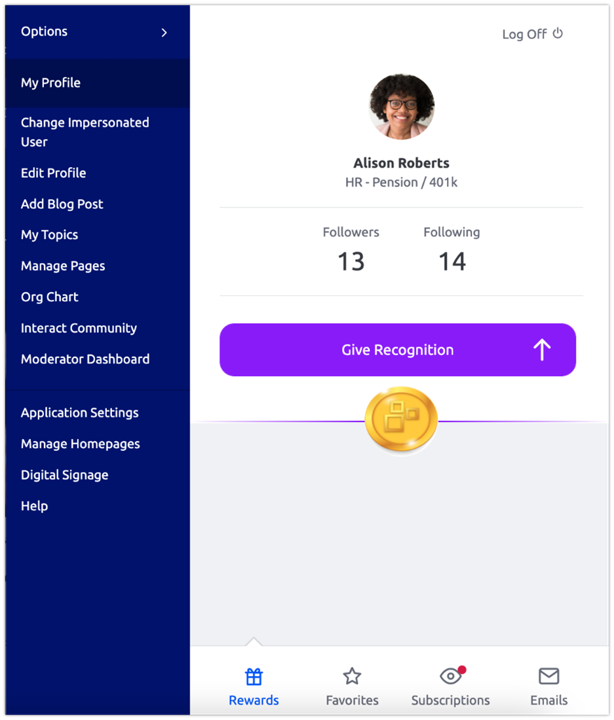
Encouraging the use of common hashtags for behaviors that mirror company values can make it even more straightforward to identify those sharing their expertise.
Yet another place to consult is intranet user profiles. One of the best reasons to ensure that everyone fully completes a user profile is that it should be a repository for people to add both Interests and Expertise. As the person responsible for managing the intranet, it should be possible to consult profiles and find the area of Expertise that most interests you (e.g., the software platform Jira), you can isolate everyone within your organization who has listed that piece of Expertise, giving you an immediate pool of subject-matter experts to work with. Then it may be as simple as contacting them and discovering who is best placed to work with you in recording that information on your intranet.

Once you’ve identified these SMEs, how can you work together to improve the content of your intranet in a way that will improve and retain organizational expertise?
Utilizing subject-matter experts for knowledge management
In terms of workflow, there are at least two main ways internal communicators can collaborate with subject-matter experts. The intended outcome of both is the production or updating of intranet content.
What does this mean in practice? Let’s take the example of data. If your company is involved in the collection, storage, and management of data belonging to private individuals (names, addresses, emails, etc.), you will likely have heard of the European Union’s General Data Protection Regulation (GDPR).
It is also probable there will be some internal guidance on what GDPR legislation means for you when you are contacting individuals or businesses. Who is it acceptable to contact and how? How long can you retain data for? What are the security considerations around data management?
How to source employee-generated content for your intranet
Where should you keep internal guidance on GDPR?
You could store information on SharePoint or another DMS, but changes in legislation may occur faster than you can update documents. Equally, complex security permissions or lack of access (e.g., workers with no M365 account) may prevent some employees from accessing key information.
The intranet is a natural and dynamic home for this material because it is possible for intranet managers to create, publish, and update content pages without having to constantly rely on designers. The pages can be kept up to date and, when important new updates are added, communicators can issue notifications via email, SMS, push notifications, and more. This has the effect of using a multichannel approach to keep everyone informed. With the addition of a mobile app, relevant users can easily view updated pages on their phones.
In order to keep some pages relevant and up to date, however, communicators and intranet managers require the expertise of SMEs. For GDPR, it may be legal counsel or another expert in the field that the comms team relies upon.
The first way to connect a subject-matter expert with intranet content is through a process of consultation. Meetings are arranged, notes are taken, and documents are created and transcribed. This can be a valuable way to work, but it has the drawback of relying on repeated meetings and the intervention of second or third-parties to continually relay and update changing information on the intranet or DMS.
There is a second way to work though, which relies more on the content creation possibilities enabled by modern intranet software. Rather than consulting subject-matter experts and then recording their expertise, it is also possible to empower them to create and update intranet content for themselves.
This has the advantage of making knowledge visible to all, giving some creative freedom to SMEs, and removing at least one person from the process.
To borrow a term from another industry, we might think of this as a “citizen developer” framework, except that in the context of intranet software and internal communication, SME co-workers become “citizen content developers”.
Empowering subject-matter experts to be “citizen content developers”

Citizen development has become popular in recent years; the concept is that by using low- and no-code software platforms (LCNC), people with no training in software development (but with expertise in their own subject areas) can build or adapt simple software applications that benefit an organization by streamlining departmental processes or adding new functionality. Gartner identifies that, like the subject-matter expert, a citizen developer is a persona, not a role.
Rather than relying on their IT team to create potentially beneficial changes in software and workflows (e.g., improving inventory management in an eCommerce company), the citizen developers are empowered to develop their own initiatives through LCNC platforms such as Salesforce or ServiceNow.
The principle for citizen content developers (or owners) is the same. These content authors do not need to be professional communicators or rely on the comms teams. With the right systems, they can be empowered to create and update intranet content so their expertise is stored for the benefit of the company.
An intranet content framework for subject-matter experts
There is no single “right” way to set people up for success, but considering the following points may help you to establish a process that enables SMEs to share knowledge. In turn, this may contribute to intranet content becoming richer and more relevant.
If in doubt, start small. Using one or two subject-matter experts to add and maintain intranet content over a six-month period may be a good way to test the idea and ensure that your governance and tools are all working optimally.
Governance
Organizations that don’t take intranet governance seriously may see a common cycle where lots of content is added initially but then is not managed or updated.
The essential internal communications guide
This can result in mixed ownership, expired documents, duplicate content, and a bloated information architecture users do not engage with. The best way to combat this is through a team of people who regularly review content for accuracy, relevance, and content gaps. The same intranet governance team should also be part of the process for identifying SMEs, training them, engaging them to create content, and reviewing it periodically.
At a strategic level, an intranet governance team should determine who is in charge of which areas, what decisions need to be made, who needs to provide input and help, and what may need to change in the business in order to achieve your aims. The team can also take a view on whether the intranet has sufficient resources.
Your governance team may operate at two levels, including those who manage the day-to-day running of the intranet and those who contribute to its overall direction. An intranet manager or internal communications professional will be at the heart of both. They will convene the steering group and orchestrate the ongoing work, such as sending comms or making page updates.
For the less frequent strategic meetings, it is best practice to involve co-workers from IT, HR, Legal, and Finance, but also to invite departmental heads (particularly if you are asking for subject-matter experts to contribute their time), and senior leaders who can create greater visibility and change larger processes when necessary.
With this governance group in place, it should be easier to discuss intranet content gaps with others in your organization, to identify the people who are best placed to rectify that (your subject-matter experts), and to establish a process of creation, management, and review.
Interact vs SharePoint and Viva
Although the goal is to empower subject-matter experts to create intranet content, the process still needs to be managed and regularly reviewed to ensure that the overall strategy is aligned and that SMEs are keeping pace with changes.
Content creation tools
When people ask about the difference between an intranet and the intranet, the answer is chiefly the separation between internal and external content. When it comes to the question of how a CMS intranet differs though, the answer is more around its capabilities for creating, communicating, and managing information.
A CMS intranet is not simply a place to host and store documents (like a DMS such as SharePoint), it is also a dynamic content creation platform where you can create engaging new webpages that keep employees connected with the information that matters.
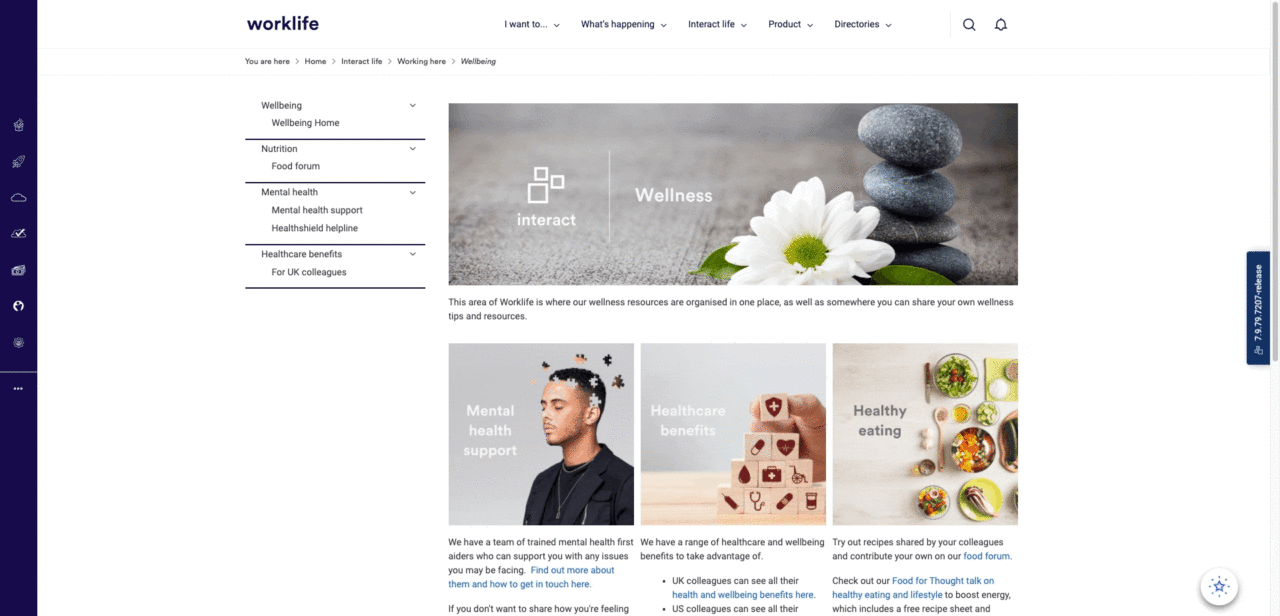
Although many of the pages your SME colleagues create will be primarily text-based, content authors may also add video, audio, or design elements that increase accessibility and engagement.
Rich-media formats such as video and images make information more appealing and may be easier for SMEs to produce than writing out comprehensive documents. Advances in audio and video editing tools for internal communication mean that self-publishing is now easy. Instead of asking an SME to write out a long summary of GDPR, for example, perhaps asking them to record themselves speaking on their mobile phone would be easier for them.
This is something that a static document buried deep in SharePoint folders can’t easily accomplish.
To use these CMS tools most effectively, subject-matter experts may require training, templates, and guidance, which is an area your intranet governance team should be set up to provide. In addition to support from the internal communication function, the intranet platform itself may also deliver features that boost SME content production. The following are some of the features that Interact offers.
Intranet editing tools
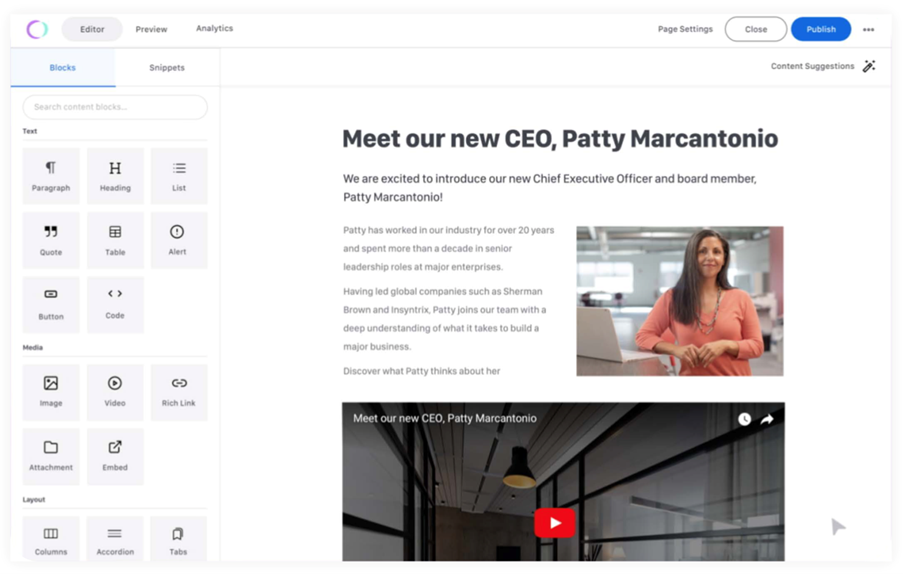
To make on-page manipulation simple, Interact’s content editor functions via drag-and-drop controls. Rather than having to build pages in a laborious way, subject-matter experts can record their knowledge easily and in a user-friendly manner.
Giving authors the option to add headings, tables, quotations, imagery, and video content blocks allows them to create content that will be engaging for internal readers. To further establish coherence across different pages, intranet managers can also create content templates usable by any page author. If they want to add images but don’t have the time to source them, an in-built link to stock photography websites can provide a simple way to add an important design element.
Inclusivity and positivity analysis
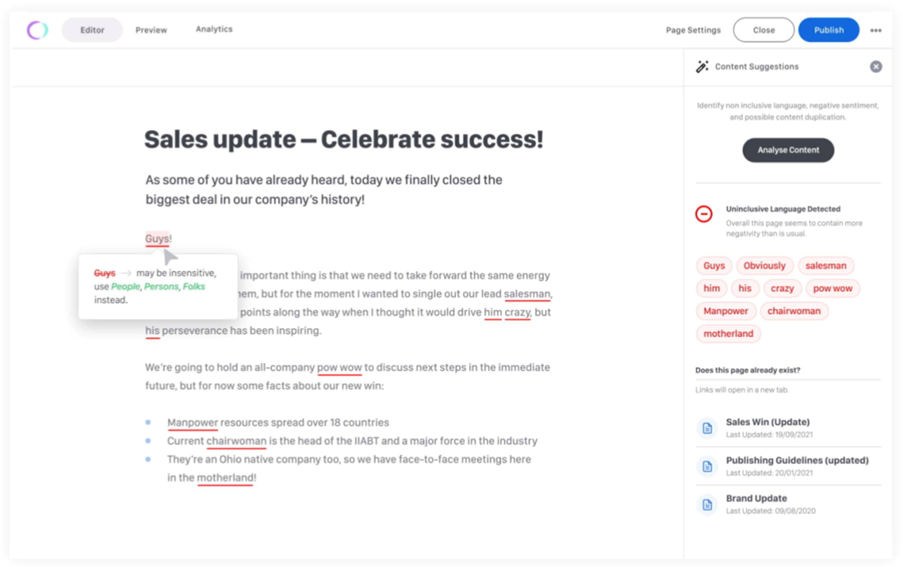
One challenge for SMEs is how to carry over topic expertise into a changing communications landscape.
Although they may be renowned contributors on a particular subject, SMEs may be less accustomed to placing their knowledge within the boundaries of evergreen intranet content or organizational communication. This is especially true when it comes to adhering to an organization’s tone of voice or being aware of continually changing inclusive language.
Recent years have seen the development of new standards for diversity, equity, and inclusivity, and language has followed suit. To help subject-matter experts when they come to write new intranet pages, an AI-powered writing assistant can instantly highlight potentially non-inclusive language or negative sentiment. By highlighting and suggesting alternative terms, the AI can give greater confidence to contributors.
The insider’s guide to internal comms technology
Auto summary
Catchy page summaries can boost engagement and increase discoverability, but not everyone is a born copywriter.
Having to distil their expert page content into just a few words can be off-putting for some people, resulting in them referring their work back to internal communicators and causing a potential bottleneck. To minimize this interruption to publication, Interact’s auto summary tool can instantly capture the important points from a page, highlighting the content for readers and making life easier for subject authors.
Whether they are small or large contributions, every step you can optimize for content authors may help to get their buy-in and encourage them to record what they know.
Don’t forget to recognize and reward
Subject-matter experts can help to make your company intranet a one-stop shop that all employees regularly use, but working with them may not always be straightforward.
First, it can be difficult to gain the buy-in of managers who control a team’s competing priorities, which means it can be challenging to then secure the time needed for SMEs to either consult on or create new content.
One way to resolve this is to have a cross-departmental intranet governance team that involves stakeholders in different roles and with multiple levels of seniority. Having a C-suite leader on board, for example, can certainly be beneficial for this as they may be able to allocate more resources when they are needed.
Secondly, however, it can be a challenge to engage enough SMEs to come forward and share their knowledge for the good of the enterprise. Good governance, forward planning, and advanced tools can help, but we also shouldn’t forget the power of publicly acknowledging and rewarding individual contributions.
As we’ve discussed previously on this website, taking the time to reward and recognize your co-workers can be an important way to raise engagement (especially when you need them to contribute to internal communications). Through intranet rewards programs, gamification, or even just mentioning people in your employee email newsletter or at All Hands meetings, you can engage your subject-matter experts and work with them to produce content that lasts.


